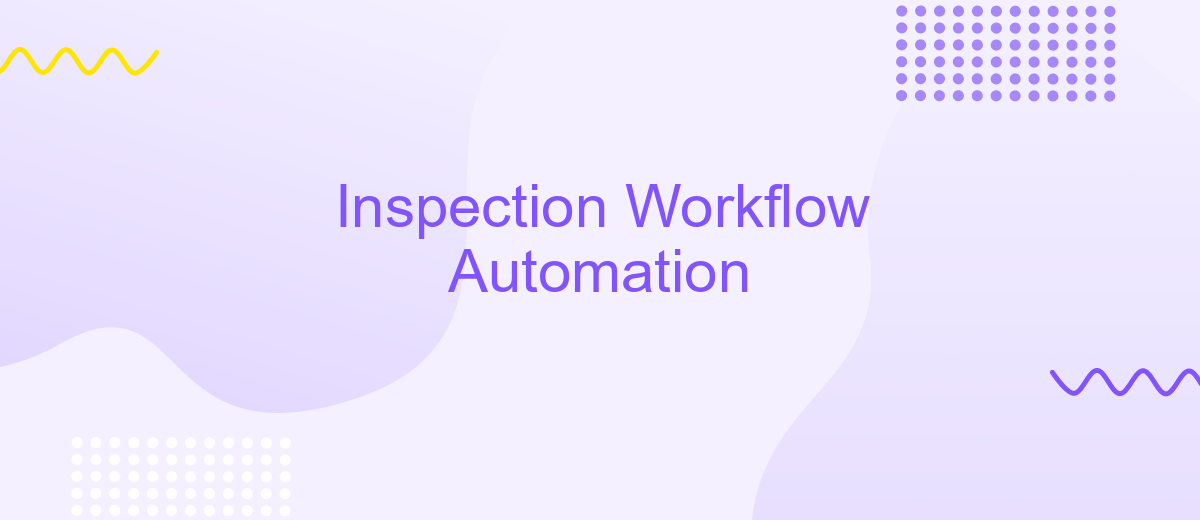Inspection Workflow Automation
In today's fast-paced industrial environment, ensuring product quality and compliance through manual inspections can be both time-consuming and prone to errors. Inspection Workflow Automation offers a transformative solution, streamlining the inspection process, enhancing accuracy, and reducing operational costs. This article explores the benefits, key features, and implementation strategies of automating inspection workflows to drive efficiency and improve overall productivity.
Why Inspection Workflow Automation?
Inspection workflow automation is essential for modern businesses seeking to enhance efficiency and accuracy in their inspection processes. By automating repetitive tasks, companies can save time, reduce human error, and ensure consistent quality across inspections. This leads to improved compliance with industry standards and regulations.
- Increased efficiency and productivity
- Reduced human error
- Enhanced compliance with standards
- Consistent quality assurance
- Time and cost savings
Integrating automation tools, such as ApiX-Drive, can further streamline inspection workflows by connecting various software and systems, ensuring seamless data transfer and real-time updates. This integration eliminates the need for manual data entry, reduces the risk of data loss, and provides a comprehensive overview of the inspection process. Ultimately, inspection workflow automation empowers businesses to focus on critical tasks, drive continuous improvement, and maintain a competitive edge.
Benefits of Inspection Workflow Automation

Inspection workflow automation offers numerous benefits that significantly enhance operational efficiency and accuracy. By automating routine inspection tasks, organizations can reduce human error, ensure consistent data collection, and accelerate the inspection process. This results in quicker identification of issues and more timely interventions, ultimately leading to improved product quality and compliance with industry standards. Additionally, automated workflows provide real-time data and analytics, allowing for better decision-making and strategic planning.
Another key advantage is the seamless integration of various tools and systems, which streamlines the entire inspection process. Services like ApiX-Drive facilitate these integrations by connecting different applications and automating data transfers, eliminating the need for manual input and reducing the risk of data discrepancies. This interconnected approach not only saves time but also ensures that all relevant information is readily accessible, enhancing overall productivity and collaboration across departments. By leveraging inspection workflow automation, businesses can achieve greater operational efficiency, cost savings, and a higher level of compliance and safety.
Key Features of Inspection Workflow Automation

Inspection Workflow Automation streamlines the entire inspection process, enhancing efficiency and accuracy. By automating repetitive tasks and integrating advanced technologies, organizations can ensure compliance, reduce errors, and save time and resources.
- Real-Time Data Collection: Automated systems collect and analyze data in real-time, ensuring accurate and up-to-date information.
- Seamless Integration: Tools like ApiX-Drive facilitate the integration of various systems and applications, enabling smooth data flow and communication.
- Automated Reporting: Generate comprehensive reports automatically, reducing manual effort and increasing consistency.
- Task Scheduling: Schedule and assign inspection tasks automatically, ensuring timely completion and compliance.
- Enhanced Accuracy: Minimize human errors by automating data entry and validation processes.
- Customizable Workflows: Tailor workflows to meet specific organizational needs, improving overall efficiency.
By leveraging these key features, organizations can transform their inspection processes, ensuring higher standards of quality and compliance. The integration capabilities provided by services like ApiX-Drive further enhance the automation process, making it easier to connect and manage various systems seamlessly.
How to Implement Inspection Workflow Automation

Implementing inspection workflow automation requires a strategic approach to ensure all processes are streamlined and efficient. Start by identifying the key areas in your inspection workflow that can benefit from automation. This includes routine tasks, data collection, and reporting.
Next, choose a reliable automation tool that fits your specific needs. ApiX-Drive is an excellent option, as it allows seamless integration with various applications and services, simplifying data transfer and task management. Ensure the tool you select is user-friendly and offers robust support.
- Identify repetitive tasks suitable for automation.
- Select an automation tool like ApiX-Drive for integration.
- Configure the tool to match your workflow requirements.
- Test the automated processes to ensure accuracy.
- Train your team on using the new system effectively.
Finally, continuously monitor and evaluate the automated processes to ensure they meet your goals. Regular updates and adjustments may be necessary to maintain optimal performance and adapt to any changes in your workflow.
- Automate the work of an online store or landing
- Empower through integration
- Don't spend money on programmers and integrators
- Save time by automating routine tasks
Best Practices for Inspection Workflow Automation
To achieve effective inspection workflow automation, it is crucial to start with a thorough assessment of your current processes. Identify repetitive tasks that can be automated and ensure that your team is trained to use new technologies. Establish clear objectives and key performance indicators (KPIs) to measure the success of the automation. Regularly review and update your workflows to adapt to changes in your business environment and technology advancements.
Integrating your inspection automation tools with other systems can significantly enhance efficiency. Utilize services like ApiX-Drive to seamlessly connect various platforms and streamline data flow. This integration ensures that all relevant information is accessible in real-time, reducing manual data entry and minimizing errors. Additionally, prioritize security and compliance by regularly updating your software and conducting audits to protect sensitive data. By following these best practices, you can optimize your inspection workflows and achieve higher productivity and accuracy.
FAQ
What is inspection workflow automation?
How can I implement inspection workflow automation in my organization?
What are the benefits of automating inspection workflows?
How do I ensure that my inspection data is secure when using automation tools?
Can inspection workflow automation be integrated with other business systems?
Strive to take your business to the next level, achieve your goals faster and more efficiently? Apix-Drive is your reliable assistant for these tasks. An online service and application connector will help you automate key business processes and get rid of the routine. You and your employees will free up time for important core tasks. Try Apix-Drive features for free to see the effectiveness of the online connector for yourself.


